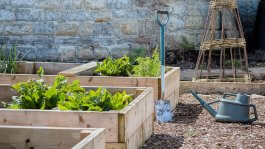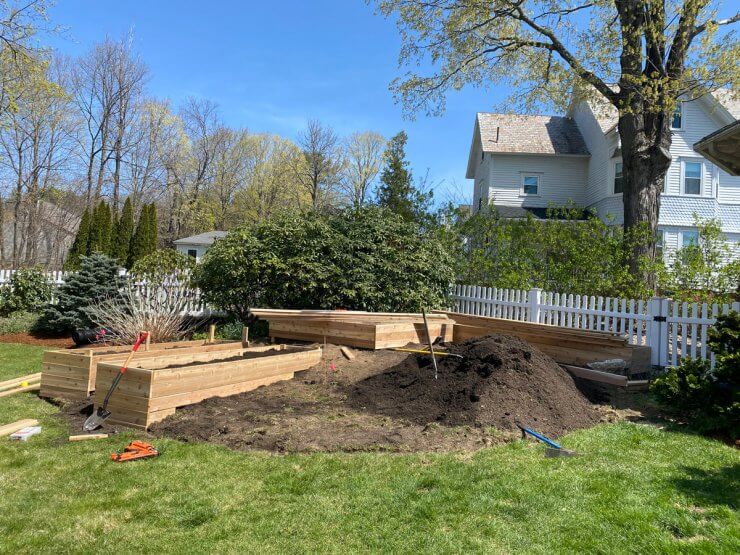
So you’ve decided to start planning raised beds for your garden, but aren’t sure where to start? Good news, I went through a pretty elaborate garden transformation just last year and lived to tell the tale. If you’re planning on building your own or having them built, I’ve put together what I consider a fairly thorough tutorial on the basics of what to ask yourself if you want to build raised beds, so let’s just jump into it!
What type of wood will you choose?
There are several considerations for types of wood when you’re building a raised bed.
Cedar is most commonly thought of as the best type of wood for raised beds. It’s largely resistant to rot and termites, and it’s relatively easy to find. It can also be expensive. As an example, a 2-inch x 6-inch x 10-foot long cedar board runs about $25. The wood will last you 15 or more years.
Redwood has a lifespan of more than 20 years, and like cedar, it’s also resistant to rot. It’s also harder to find than cedar, and it ain’t cheap. An 8-foot redwood board is in the $30 range.
Pine is a softer wood and won’t last nearly as long as cedar or redwood. However, it’s also inexpensive. We’re talking around $15 for a 10-foot board.
You have more options, of course. A lot of people like juniper because it’s resistant to insects and rot. It’s a little more challenging to find, but it will also last more than 50 years! There’s also Douglas fir, which has a long history in housing construction. It’s also very affordable but tends to have a much shorter lifespan.
Whichever wood you choose, don’t use treated or pressure-treated woods as raised beds in an edible food garden, because they’ve been treated with chemicals. Some gardeners choose to use this wood and just line their beds so the soil doesn’t touch the wood, but experts agree it’s better to avoid it.
Wood isn’t the only option, though. You can also build raised beds with concrete and bricks, but the downside of that is slugs love these materials, whereas the scent of wood can actually deter some pests. Other options are plastic and plastic composites, and a lot of people love their metal troughs. Materials are all up to you, your budget, and how much customization you want or need.
Will your beds be flat or will they be built into a hill?
When planning raised beds, your terrain is everything. Building a raised bed on flat ground can be as easy or as hard as you want to make it. You could simply buy four 2×4’s, hammer them together, and call it a day if you wanted to.
Where it gets complicated is when you’re building raised beds into slopes like mine. But as you can see, it’s as simple as trimming your board as needed to accommodate the hill. The important thing is to make sure the bed is secured into the soil. Inside the bed, create braces in the corners and midway through the beds to keep the boards firmly together. Only use screws long enough to penetrate the second board, not long enough to go through it, or you’ll end up with an injury later down the road while digging in your garden.
My current garden is actually on a slope, which turned out to be even more slope-y than I had expected when we built our new raised beds. You can see in the front, the beds are almost two feet, and by the time you reach the backs, they’re barely 6 inches off the ground.
To do this, the beds started with four boards and were trimmed to accommodate the slope, then filled in with soil around them.

What size should the bed(s) be?
The dimensions of your raised beds depend on the space you’re working with, and more importantly, what you want to grow. So for example, if you want to grow three tomato plants, you’d need a raised bed that can accommodate 36” wide plant, so you’d need at least a 9-foot bed by at least 36” wide. If you were planting corn, you would want a 10’ x 10′ raised bed.
For someone who has mobility issues, an above ground garden at waist height would be ideal and a bed of 3′ x 6′ would be a good size to be able to reach both sides of the bed pretty easily while still being able to plant things like tomatoes. Besides accommodating mobility issues, bed height should also based on personal preference and your soil. So for example if you had clay soil, we’d recommend building a taller raised bed of 24”, but if your soil is good, then 8-12” would be perfectly adequate.
How far apart should your beds be, and what should be between them?
What you decide to use between your beds might be the best indicator of how far apart they should be. For example, if you’re keeping grass between your beds, you want the space to be wide enough to mow through. If you’re using weed fabric covered by mulch or stone, you just need to consider:
- your wheelbarrow and how easy will be able to navigate it through the rows when needed.
- how much space you personally want or have
- whether you’ll be using a gardening stool and how wide that is
The spacing between rows is purely up to you, though I did about 2-3 feet between my rows to fit my wheelbarrow.
How do you fill the beds?
If you’re planning raised beds and building more than one, you’ll want to order a delivery of organic topsoil from your local landscaping company. Some places will even shovel it into your beds for a fee, but otherwise they’ll just dump it wherever you ask them to.
Filling raised beds can take a lot of soil, especially ones that reach 24” high or more.
For example, if you build 3×6′ bed that was 18″ high, you’d need 1 cubic yard of topsoil. There are topsoil calculators like the one on Gardeners.com that will tell you how much soil you need to fill a raised bed.
Then you’ll need to amend it.
No gardener will agree on this, but a common mix is 60% topsoil, 30% compost, and 10% potting soil. That said, many people go with a more simple mix of 50/50 topsoil and compost, but that depends on you making your own compost since it can be expensive to buy.
Once you get your soil, do a soil test so you know what you’re starting with.
Should you build a trellis?
If you can, you should. There are so many ways to use a trellis, whether you’re supporting tomatoes, growing pole beans, or anything in between, you can always use a trellis.
Should you build an arbor?
If you have two raised beds next to one another, I say why not create a walk-through arbor between them? You can create a hanging cucumber or gourd garden if you want!
Should you line the bottom of the bed?
Weed liners only do so much, and cardboard will break down, so unless you have a big weed problem or you planted over some veracious perennials that you think will come back, you probably don’t need to line the bottom of your beds.
I like to make sure my plants can easily burrow into the soil beneath my beds so I chose not to add a bottom liner.
That said, lining the sides of your garden bed can be helpful. Any type of non-permeable material can be used to keep the soil off the frame of your garden bed and it can help your raised beds last a few more years.
How do you irrigate a raised bed?
Raised beds dry out quickly so irrigation is usually needed. Vermiculite added to the soil can help with moisture retention, but it won’t solve the issue entirely. Like all gardens, sprinklers should be a last resort because they leave water on leaves which can lead to disease. The best way to irrigate a raised bed is at the root zone with drip irrigation through drip lines, soaker hoses, or drip tape. I created a tutorial on how to do it yourself last year for less than $100.
That system worked great all last year, but this year I decided to get it professionally done (about $900 for 6 beds) because I made a mess of it when I cleaned out the garden this year and didn’t want to re-build it. Also, I wanted to get a spigot closer to the garden which you can do when you go the PVC route.
Are you ready to winterize?
Building raised beds means that you now have an asset to protect and preserve for a long time. To do that, I like to cover my beds in the winter to protect the wood and prevent spring seeds from embedding themselves.
You’ll also want to re-secure nails each spring, and perform any necessary maintenance to keep them in tip-top shape.
Do you have any other questions about planning raised beds? I’m so happy we built ours.


 Previous
Previous


I have seen lots ytube regarding raise bed. It’s said it’s okay to use the treated wood( the problems before was resolved). And also I used lots of wood chips, you never mentioned so not sure if it’s right.
I find that the 4″x8″x16″ cinder blocks are as cheap or cheaper than wood, and give you a slightly taller side at a full 8″, which is a nice depth for your added soils. I use construction adhesive to adhere the blocks together. 20 blocks make a really nice 4’x9.3′ bed that is 4″ wide, which you can stand on, kneel on, and totally maintenance free for a really long time… At around $2.59 a block, that’s about $55, plus a tube of construction adhesive.. Very reasonable. Of course it takes a little longer to assemble than wood and nails, but it’s definitely worth the time and effort.